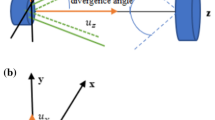Abstract
In this research, we have examined the performance of a link in an underwater visible light communication (UVLC) system using an intensity-modulated/direct detection (IMDD) system. Underwater visible light communication (UVLC) plays a pivotal role in shaping the future of underwater wireless networks. In most cases, the performance of UVLC links is adversely affected by factors such as atmospheric attenuation, scattering, and turbulence, which mainly affect high data rate distance communication and the bit-error rate (BER) of the UVLC system. The utilization of highly sensitive Avalanche Photodiodes (APD) represents one of the mitigation techniques employed to alleviate the influence of atmospheric attenuation, scattering, and turbulence in UVLC systems. Both Avalanche Photodiodes (APD) and PIN photodiodes are employed as strategies to mitigate the adverse effects resulting from atmospheric attenuation, scattering, and turbulence in UVLC systems, which hinders long-distance communication with high data rate. We conducted a performance comparison, evaluating the Bit Error Rate (BER) at various data rates, for both PIN and Avalanche photodiodes. As the data rate increases, the achievable communication link distance decreases, while maintaining the targeted BER of \(10^{ - 5}\). Our observations indicate that the Avalanche Photodiode (APD) consistently exhibits superior performance when compared to the PIN photodiode.





Similar content being viewed by others
Data Availability
The datasets generated or analyzed during this current study are available from the corresponding author on reasonable request.
References
Adamchik, V.S., Marichev, O.I.: The algorithm for calculating integrals of hypergeometric type functions and its realization in REDUCE system. In: Proceedings of the International Symposium on Symbolic and Algebraic Computation, pp. 212–224 (1990)
Ali, M.F., Jayakody, D.N.K., Li, Y.: Recent trends in underwater visible light communication (UVLC) systems. IEEE Access 10, 22169–22225 (2022)
Ata, Y., Baykal, Y.: Scintillations of optical plane and spherical waves in underwater turbulence. JOSA A 31(7), 1552–1556 (2014)
Chiani, M., Dardari, D., Simon, M.K.: New exponential bounds and approximations for the computation of error probability in fading channels. IEEE Trans. Wirel. Commun. 2(4), 840–845 (2003)
Elamassie, M., Uysal, M.: Vertical underwater visible light communication links: channel modeling and performance analysis. IEEE Trans. Wirel. Commun. 19(10), 6948–6959 (2020)
Jamali, M.V., Nabavi, P., Salehi, J.A.: MIMO underwater visible light communications: comprehensive channel study, performance analysis, and multiple-symbol detection. IEEE Trans. Veh. Technol. 67(9), 8223–8237 (2018b)
Jamali, M.V., Salehi, J.A.: On the BER of multiple-input multiple-output underwater wireless optical communication systems. In: 2015 4th International Workshop on Optical Wireless Communications (IWOW), pp. 26–30. IEEE (2015)
Jamali, M.V., Mirani, A., Parsay, A., Abolhassani, B., Nabavi, P., Chizari, A., Khorramshahi, P., Abdollahramezani, S., Salehi, J.A.: Statistical studies of fading in underwater wireless optical channels in the presence of air bubble, temperature, and salinity random variations. IEEE Trans. Commun. 66(10), 4706–4723 (2018)
Jiang, H., Qiu, H., He, N., Popoola, W., Ahmad, Z., Rajbhandari, S.: Performance of spatial diversity DCO-OFDM in a weak turbulence underwater visible light communication channel. J. Lightwave Technol. 38(8), 2271–2277 (2020)
Korotkova, O., Farwell, N., Shchepakina, E.: Light scintillation in oceanic turbulence. Waves Random Complex Media 22(2), 260–266 (2012)
Lu, W., Liu, L., Sun, J.: Influence of temperature and salinity fluctuations on propagation behaviour of partially coherent beams in oceanic turbulence. J. Opt. A. Pure Appl. Opt. 8(12), 1052 (2006)
Pandey, P., Agrawal, M.: Implementation of MIMO concept for underwater visible light communication system. Opt. Quant. Electron. 55(5), 414 (2023)
Pandey, P., Matta, G., Agrawal, M.: Effect of transmitter divergence-angle on the performance of underwater visible light communication system. Opt. Quant. Electron. 54(12), 802 (2022a)
Pandey, P., Agrawal, M.: High speed and long range underwater optical wireless communication. In: Global Oceans 2020: Singapore–US Gulf Coast, pp. 1–10. IEEE (2020)
Pandey, P., Matta, G., Aggarwal, M.: Performance comparisons between Avalanche and PIN photodetectors for use in underwater optical wireless communication systems. In: OCEANS 2021: San Diego–Porto, pp. 1–8. IEEE (2021)
Pandey, P., Matta, G., Aggarwal, M.: Effect of variable LED rise time on high speed OOK underwater visible light communication system. In: OCEANS 2022, Hampton Roads, pp. 1–6. IEEE (2022)
Pandey, P., Matta, G., Aggarwal, M.: Impact of variable aperture area of receiver on high-speed OOK underwater visible light communication system. In OCEANS 2022, Hampton Roads, pp. 1–7. IEEE (2022)
Popoola, W.O., Ghassemlooy, Z., Allen, J.I.H., Leitgeb, E., Gao, S.: Free-space optical communication employing subcarrier modulation and spatial diversity in atmospheric turbulence channel. IET Optoelectron. 2(1), 16–23 (2008)
Tabeshnezhad, A., Pourmina, M.A.: Outage analysis of relay-assisted underwater wireless optical communication systems. Opt. Commun. 405, 297–305 (2017)
Wang, X., Zhang, M., Zhou, H., Ren, X.: Performance analysis and design considerations of the shallow underwater optical wireless communication system with solar noises utilizing a photon tracing-based simulation platform. Electronics 10(5), 632 (2021)
Yang, F., Cheng, J., Tsiftsis, T.A.: Free-space optical communication with nonzero boresight pointing errors. IEEE Trans. Commun. 62(2), 713–725 (2014)
Funding
Research is sponsored by Power Grant (SPG/2021/000753) of Science and Engineering Research Board, India.
Author information
Authors and Affiliations
Contributions
PP evaluated the system’s performance and wrote the manuscript. MA validated the results and reviewed the manuscript.
Corresponding author
Ethics declarations
Competing interests
The authors declare no competing interests.
Conflict of Interest
The authors declared that they have no known competing financial interests or personal relationships that could have appeared to influence the work reported in this paper.
Ethical Approval
Not applicable.
Additional information
Publisher's Note
Springer Nature remains neutral with regard to jurisdictional claims in published maps and institutional affiliations.
Rights and permissions
Springer Nature or its licensor (e.g. a society or other partner) holds exclusive rights to this article under a publishing agreement with the author(s) or other rightsholder(s); author self-archiving of the accepted manuscript version of this article is solely governed by the terms of such publishing agreement and applicable law.
About this article
Cite this article
Pandey, P., Agrawal, M. Performance analysis of high data rate underwater visible light communication system using avalanche photodiode. Opt Quant Electron 56, 638 (2024). https://doi.org/10.1007/s11082-024-06318-6
Received:
Accepted:
Published:
DOI: https://doi.org/10.1007/s11082-024-06318-6




